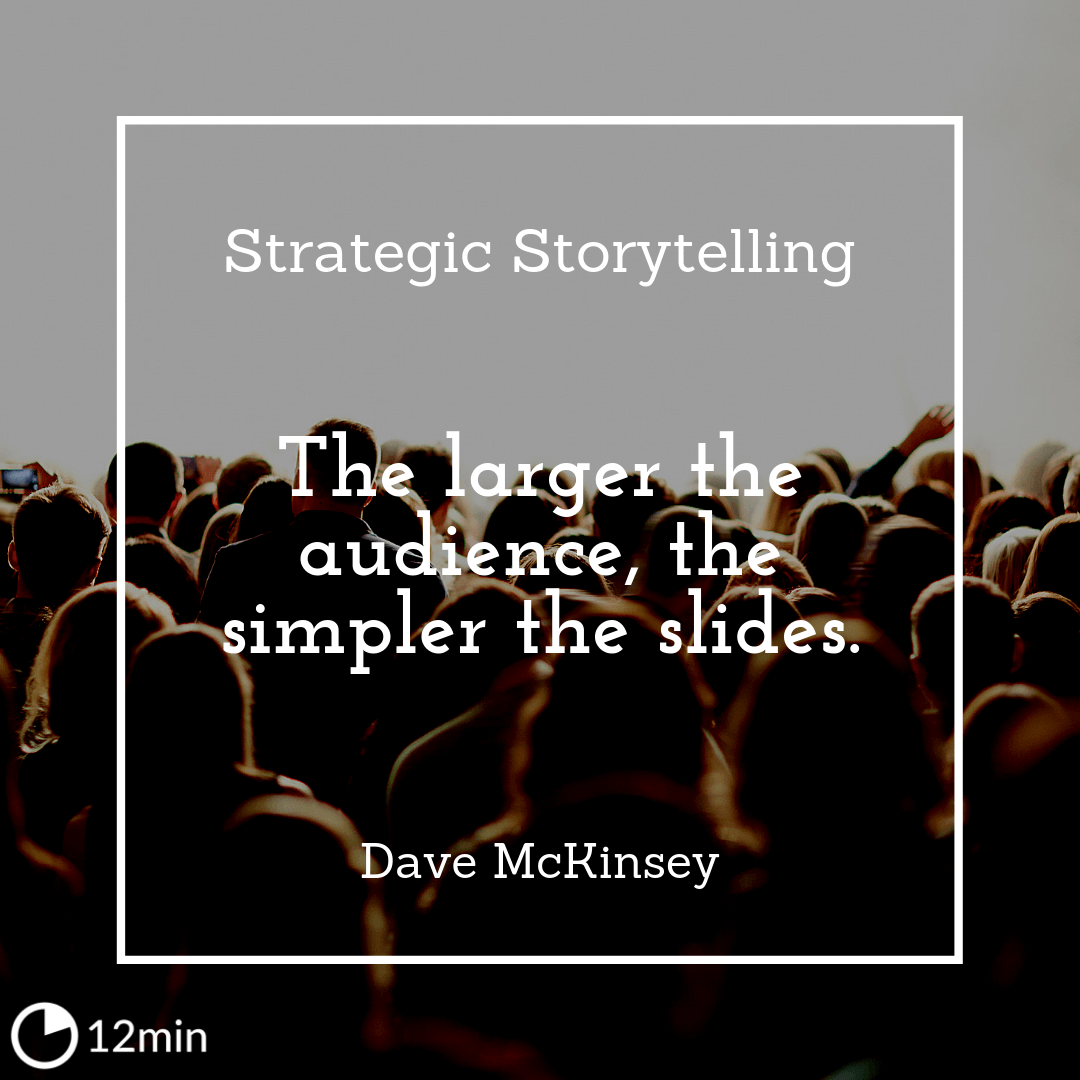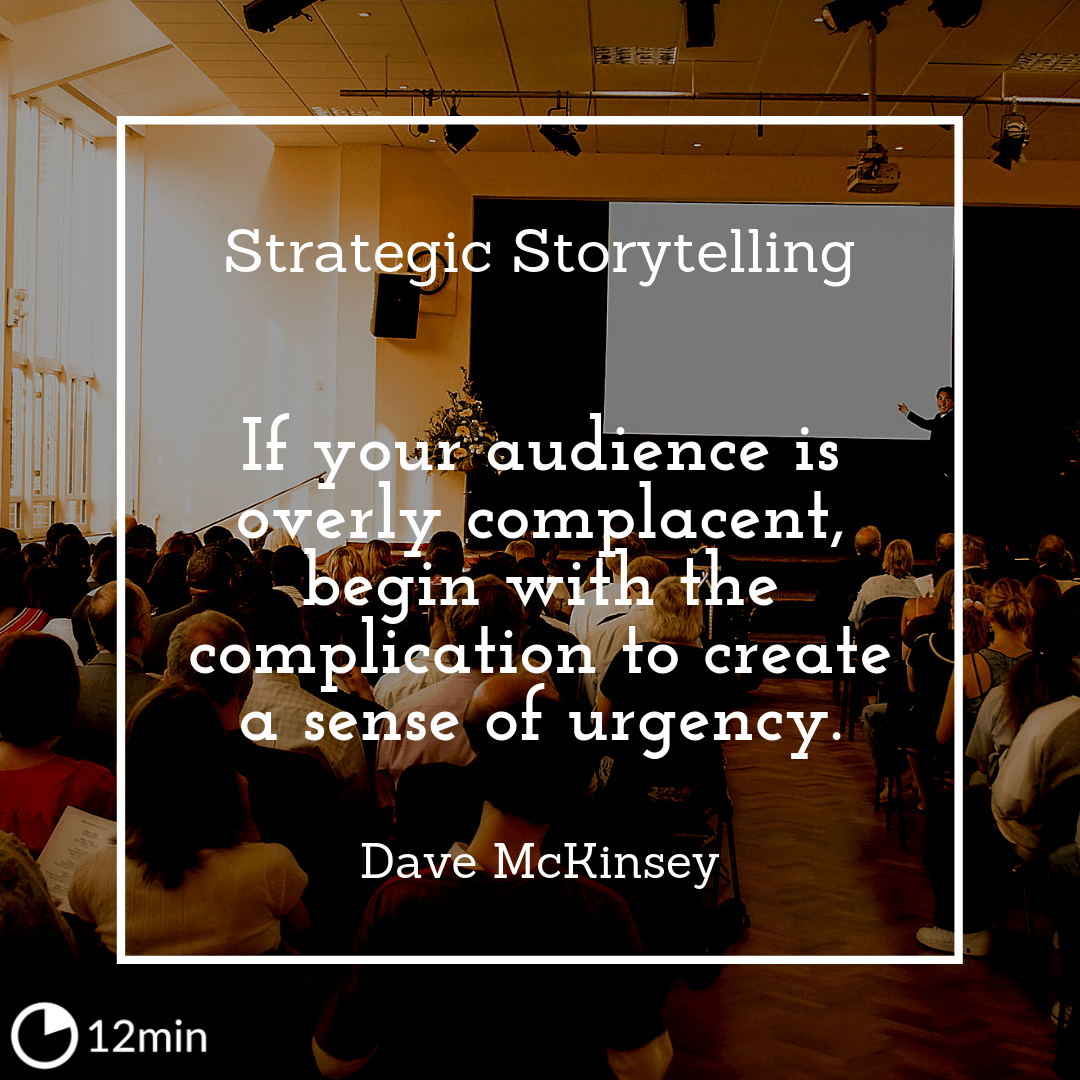Strategic Storytelling Summary
5 min read ⌚
MicroSummary: Dave McKinsey’s Strategic Storytelling: How to Create Persuasive Business Presentations focuses on delivering great presentations to smaller audiences. You’ll find the 87 tips presented in the book very useful if you need to pitch an idea to a partner, deliver a speech in front of your colleagues or run a business meeting where important decisions need to be made. It’s a great step-by-step guide that shows you how to construct and deliver great presentations.
How to Create Persuasive Business Presentations
It’s split into 21 chapters and 3 main sections that’ll guide you through subjects like content, design, and delivery.
Not only is Strategic Storytelling very thorough, it’s also filled with practical examples of presentations delivered by consultancy companies.
McKinsey realized that many of us don’t have access to what happens behind closed doors in a company and there isn’t a book on the market that describes that.
So he managed to get publicly-released presentations from three consulting companies and guide us through their models.
By taking each individual slide and analyzing not only the information provided and the construction of the charts and data, but also the design of the slides, the titles and the agenda, he helps us understand better how to build a successful business presentation.
GUIDANCE / STRATEGIC STORYTELLING
Strategic storytelling is mostly about what you do before you actually speak to a group.”
“Strategic Storytelling Summary”
One of the most important things we need to remember when delivering a presentation in front of a smaller audience is that we’re not there to necessarily teach them anything new.
The audience is probably formed by our peers, our colleagues, bosses or partners.
We should engage in meaningful debates and discussions and not deliver a sterile presentation that’ll bore the audience.
Dave McKinsey is among those rare authors who use their knowledge to conduct a case study. With an impressive background, he presents a project meant to educate the public.
“Strategic Storytelling” is a book that refers to all sides (the good, bad) of any situation and then it uses the best practices along the way to clarify the presentation.
McKinsey focuses on everything, from simple details like the importance of page numbering and logo design/placement to rules to follow, how to read content, data configuration, and a guide of dos and don’ts
GetNugget has a task to get the best out of this book summary and help the reader to navigate easily throughout the book summary.
These useful takeaways from McKinsey’s book talk about few basic, formulas for distributing categories of high-quality presentations.
Here, the author declares that presentations which are a part of every business meeting in the world play a huge role in our lives.
Use GetNugget’s helpful insights to become a successful storyteller and use that strategic advantage for your benefits.
The first few tips presented in Strategic Storytelling consist of ideas that on how to keep the design of your presentation simple and clear.
From the title to the slide where you present your agenda, from the colors and background that you use, it should all combine together to form a clean presentation:
“Black text on a white background is so familiar that we do not even think of it as a design choice. Yet, it is a choice; a choice that connotes neutrality and simplicity.”
This is especially relevant if you’re talking to a larger audience. Sometimes you may need to take the presentation from the boardroom to the entire company.
The slides can’t be filled with complicated text and charts because the audience will spend a lot of time trying to decipher them, instead of listening to you and engaging in the conversation.
The first question you should ask yourself however is, do you really need slides?
Do they really add value to your presentation? Or will they just distract the audience, make them feel distant? McKinsey recommends that you “only use slides when they accelerate decision-making”.

If you’re talking to a smaller audience, with the same technical background as you, then it’s OK to use specialized terms, charts and as much complex data as you feel necessary in order to present a problem.
But as your audience becomes larger and less specialized, keep your presentation and your slides as simple as possible, maybe only showing some compelling photos and simple charts that back your ideas.
The step which includes all the processes that trigger the delivery of the presentation is always the one that matters the most.
You need to focus on the most important pieces of information, make sure you have clean slides and that your delivery is perfect.
As McKinsey tells us, it’s important to offer the audience only as much information as they need. Don’t bombard them with useless slides.
Most of the time you discover a lot of information during the research phase.
In order to create a meaningful and interesting presentation, you need to use only the best ideas and data and present it in a way that’ll engage the audience and keep them focused:
“Give your audience only what it needs, no less and no more, to comprehend your story, decide, and take action.”
Some of the information in the book might seem obvious, but many of us still make big mistakes when constructing a presentation.
Strategic Storytelling is very helpful because it deals with every small detail of a presentation, giving you an overall picture of how to create your own.
It’s important to keep in mind that usually, in business presentations, you prepare for a discussion with your peers or the board.
You want to make a decision in the end. It’s not a presentation in which you want to only motivate or present some facts. At the end of the meeting, important decisions need to be made.
This is why the structure of the presentation and the way you deliver it needs to encourage people to think about the questions you raised and eventually make a decision.
Another thing that I really liked about the book was all the advice about how to use pie charts, waterfalls and other graphics. I always struggle with presenting data and now I have a clearer view about this in my mind.
McKinsey, like me, is reluctant to use videos in presentations. We’ve all struggled with playing videos, something always goes wrong, and if they’re too long people will get bored. That’s why this topic isn’t covered in his book.
Until technology improves in this area, you’re advised to not use a lot of videos, if any, in your presentation.

Public speaking is scary for a lot of people.
But what we should realize is that many of us will most likely have to deliver presentations in smaller groups.
We should prepare for situations where we deliver pitches in boardrooms or in front of our colleagues, not necessarily in front of hundreds of people.
Like this summary? We’d Like to invite you to download our free 12 min app, for more amazing summaries and audiobooks.
“Strategic Storytelling” Quotes
A great leader, one who applies bright spot analysis, does not trust sales managers to know who their top performers are. Yes, that is blasphemy, but sales managers are people too, and hold biases due to personal relationships and past… Click To Tweet When prioritizing, it is common to use a two-by-two matrix. Click To Tweet The most compelling business presentations are a form of strategic storytelling leading listeners down a controlled path. Click To TweetOur Critical Review
Strategic Storytelling is the perfect tool to help you create a persuasive, clean and clear presentation.
It’ll show you what situations require a PowerPoint presentation, or when you could just speak or draw on a flipchart instead in order to start a meaningful conversation with the people in the room.
Emir is the Head of Marketing at 12min. In his spare time, he loves to meditate and play soccer.







